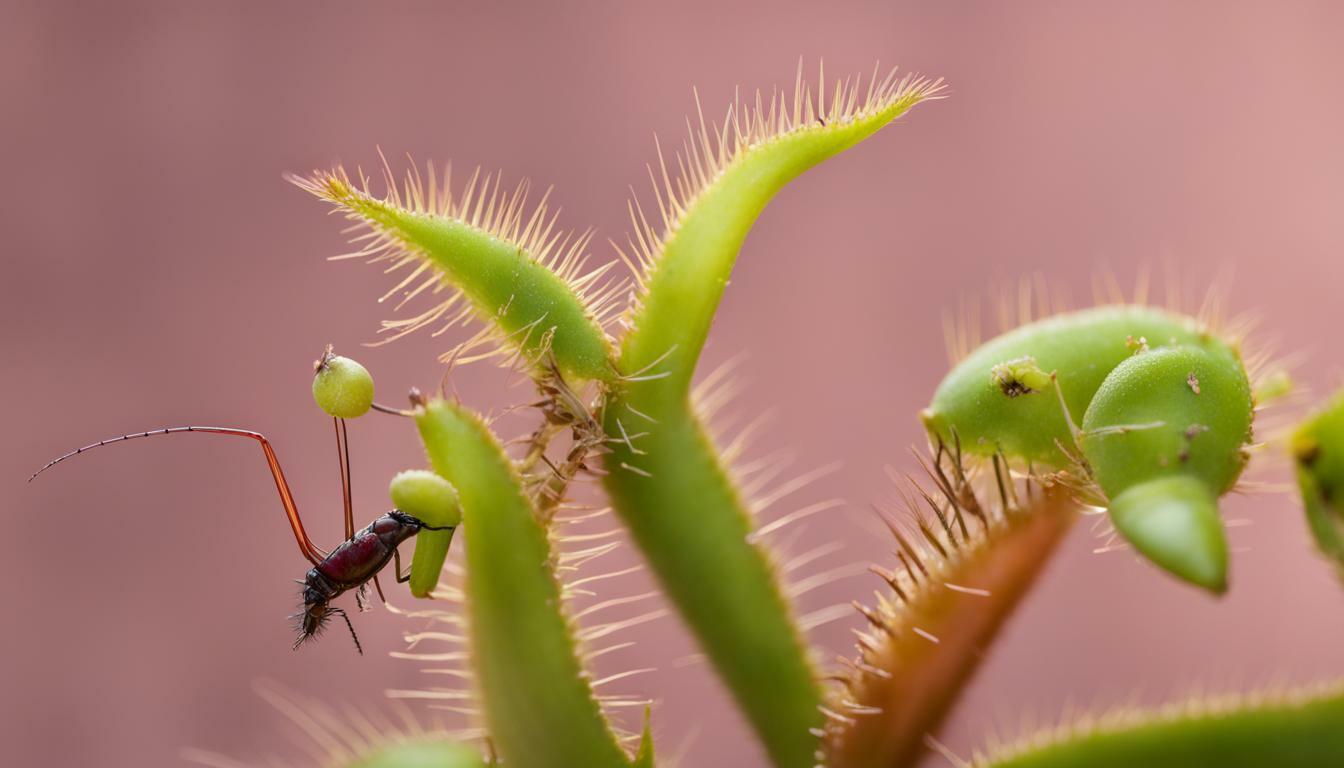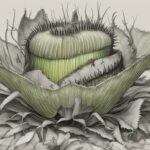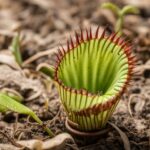Venus flytraps are fascinating plants known for their carnivorous feeding habits. One of the most common questions people have is how long it takes for a Venus flytrap to eat a fly. Understanding the timeline and process of fly consumption by Venus flytraps can provide fascinating insights into this unique plant’s behavior.
Let’s explore the Venus flytrap’s feeding habits, including the fly consumption rate and digestion period.
Key Takeaways:
- The Venus flytrap is a carnivorous plant that primarily feeds on insects, with flies being a preferred food source.
- After capturing the fly, the Venus flytrap secretes digestive enzymes onto the trapped insect to break down its tissues.
- The consumption rate varies depending on the size of the prey and environmental conditions, taking anywhere from five to twelve days on average to fully consume a fly.
The Venus Flytrap Feeding Process
The Venus flytrap is a unique and fascinating plant that feeds primarily on insects, particularly flies. When a fly lands on the trigger hairs of the Venus flytrap’s leaves, they trigger the trapping mechanism. The trap closes quickly, capturing the insect inside.
The Venus flytrap’s feeding process is efficient and fast, usually closing within a fraction of a second. Once the trap is closed, the digestion process begins, which can take several days to complete. During this time, the fly is broken down into parts, and the Venus flytrap absorbs the nutrients through the digestive enzymes it secretes onto the trapped insect.
The speed of the Venus flytrap’s feeding process varies depending on several factors, such as the size of the prey and environmental conditions. However, on average, it takes between five to twelve days for a Venus flytrap to fully consume a fly.
The Venus Flytrap Feeding Process
After capturing the fly, the Venus flytrap secretes digestive enzymes onto the trapped insect which breaks down its tissues. Once the fly has been broken down into parts and nutrients are extracted, the Venus flytrap slowly digests the insect. As it digests the fly, it absorbs the nutrients, and any indigestible parts of the prey will be discarded.
It is important to note that Venus flytraps do not consume insects only for nutrition but also to extract vital nutrients not easily obtainable from their native soil. This helps them to survive in nutrient-poor environments.
| Factors affecting feeding time | Description |
|---|---|
| Size of prey | The size of the prey can influence the duration of the feeding process. Larger prey may require more time for digestion. |
| Environmental conditions | The speed at which Venus flytrap processes its prey can be affected by environmental conditions like temperature and humidity. |
It takes several days for the Venus flytrap’s trap to reopen after the insect has been fully digested and absorbed. During this time, the plant prepares itself for its next potential meal.
The feeding habits of Venus flytraps are fascinating and offer insight into the unique behavior of this carnivorous plant. By understanding the timeline and process of fly consumption, we can appreciate the marvel of nature that is the Venus flytrap.
Fly Consumption Rate
After capturing the fly, the Venus flytrap secretes digestive enzymes onto the trapped insect. These enzymes break down the fly’s tissues, allowing the plant to absorb the nutrients. The consumption rate varies depending on the size of the prey and environmental conditions. On average, it can take anywhere from five to twelve days for a Venus flytrap to fully consume a fly.
The rate at which the Venus flytrap digests the fly can also depend on the plant’s size and health, as well as the number of traps actively digesting prey. Larger and healthier plants may have a faster fly consumption rate, while smaller or weaker plants may take longer to fully digest their prey.
It is important to note that the Venus flytrap’s feeding process is not solely for nutritional purposes. While the plant does obtain valuable nutrients from the digested flies, it also extracts vital nutrients not easily obtainable from the nutrient-poor soil of its native habitat.
Factors Affecting Feeding Time
Several factors can influence the duration of a Venus flytrap’s feeding process. The size of the fly itself plays a significant role in the Venus flytrap eating time. If the prey is more significant, it may require more time for digestion. On the other hand, smaller flies may be consumed more quickly. Additionally, environmental conditions such as temperature and humidity can impact the speed at which the plant processes the fly. A Venus flytrap in warm and humid weather may digest its prey more quickly than one in colder and drier conditions.
It is important to note that Venus flytraps do not consume flies solely for nutrition but also to extract vital nutrients not easily obtainable from their native soil. Therefore, the Venus flytrap’s fly digestion period helps it to supplement its diet and maintain its health. Understanding these factors can provide insight into how the Venus flytrap functions as a carnivorous plant.
Fly Digestion and Trap Reopening
As mentioned earlier, the Venus flytrap secretes digestive enzymes onto the trapped insect once the trap has been closed. The enzymes break down the tissues of the fly, allowing the plant to absorb the nutrients. This process can take anywhere from five to twelve days, depending on the size of the prey and environmental conditions.
Once the nutrients have been extracted, the trap will reopen, and any remaining indigestible parts of the prey will be discarded. This reopening process can take several days, during which the Venus flytrap prepares itself for its next meal.
It’s important to note that Venus flytraps do not consume flies solely for nutrition purposes but also to extract vital nutrients not easily obtainable from their native soil. By consuming insects, Venus flytraps are ensuring their survival in their unique habitats.
Conclusion
Now that you understand the feeding habits of Venus flytraps, you can appreciate the time it takes for a fly to be consumed. Factors such as the size of the fly and environmental conditions can impact how long the consumption process lasts. On average, it can take anywhere from five to twelve days for a Venus flytrap to fully consume a fly. It’s fascinating to think about the efficiency and unique behavior of these carnivorous plants.
Does High Humidity Affect the Digestion Process of Venus Flytraps?
High humidity can have a significant impact on the digestion process of Venus flytraps. These carnivorous plants rely on trapping and digesting insects for nutrients. However, during periods of high humidity, the captured insects decompose at a slower rate, affecting the efficiency of digestion for the venus flytraps and high humidity. This can lead to potential nutrient deficiencies and hinder their overall growth and survival.
FAQ
Q: How long does it take for a Venus flytrap to eat a fly?
A: The time it takes for a Venus flytrap to eat a fly can vary depending on factors such as the size of the fly and environmental conditions. On average, the consumption process can last anywhere from five to twelve days.
Q: What is the Venus Flytrap feeding process?
A: When a fly lands on the sensitive trigger hairs of the Venus flytrap’s leaves, it triggers a rapid closure of the trap, capturing the insect inside. The trapping mechanism is quite efficient, often closing within a fraction of a second. Once closed, the process of consuming the fly begins.
Q: How fast does a Venus Flytrap consume flies?
A: After capturing the fly, the Venus flytrap secretes digestive enzymes onto the trapped insect. These enzymes break down the fly’s tissues, allowing the plant to absorb the nutrients. The consumption rate varies depending on the size of the prey and environmental conditions. On average, it can take anywhere from five to twelve days for a Venus flytrap to fully consume a fly.
Q: What factors affect the feeding time of a Venus Flytrap?
A: Several factors can influence the duration of a Venus flytrap’s feeding process. The size of the fly itself plays a significant role, as larger prey may require more time for digestion. Additionally, environmental conditions such as temperature and humidity can impact the speed at which the plant processes the fly.
Q: What happens after a Venus Flytrap eats a fly?
A: As the fly’s tissues are broken down and absorbed, the Venus flytrap slowly digests the insect. Once the nutrients have been extracted, the trap will reopen, and any remaining indigestible parts of the prey will be discarded. This reopening process can take several days, allowing the plant to prepare for its next potential meal.











